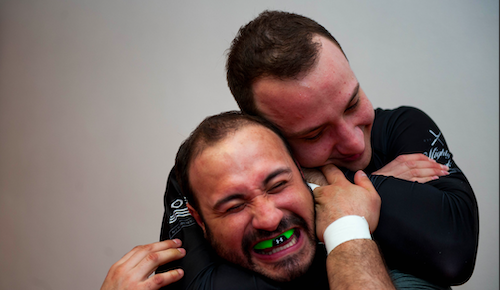
Recently a few patients of mine forwarded to me a very well written and informative blog article regarding the risk of developing a stroke by training BJJ. Many of my patients love and train hard BJJ but some are also very self-conscious about their health, and reading that article got some of them little bit concerned and question the fact if practicing BJJ, although all the love they have for it, is worth taking the risk. Here is my response, which I put here public in the hope that it will help other practitioners who have concerns.
Stroke in BJJ, is the risk real?
Yes, there is a risk of developing a stroke training BJJ. In his post, the author mentioned that he counted about 65 cases over the past few years. There are probably more out there, but the lack of centralized database for injuries happening in BJJ tournament or practice makes it hard to have a clear number. It is also important to keep these numbers in perspective. Although each of these cases is a huge tragedy for the victims and their families, those numbers are relatively low in comparison to the amount of practitioners and training sessions happening each year. According to the CDC, there is close to 800,000 strokes per year in the USA. So BJJ is not what we should call a risky activity in regards to stroke. The truth is, the large majority of BJJ practitioners will train all their lives without encountering anyone suffering from a stroke induced by BJJ.
How does a stroke happen?
A stroke happens when there is a lack of blood supply to the brain for a sustained period of time. There are 2 pairs of blood vessels going to our brain: 2 carotid arteries in the front, and 2 vertebral arteries in the back. If one of them get clogged by a blood clot typically, it will cause a stroke. Passing out from getting choked is NOT a stroke, but it mimics temporary the effect, hence the loss of consciousness. Another way to get a stroke, which is more related to BJJ training, is when the wall of a blood vessel tears and blood starts to leak out (that’s called an artery dissection).
In the context of BJJ, the risk of getting a stroke comes mainly from getting choked. Arteries are actually quite resistant against compressive forces, but so much with shearing forces. THEREFORE, GETTING THE HEAD TWISTED WHEN GETTING CHOKED IS NOT THE BEST THING TO DO, AS IT APPLIES SHEARING FORCES IN THE BLOOD VESSELS. Extreme neck rotation combined with any kind of quick jolt in the head (for instance if you land in your head after a takedown) can be risky too.
Is there a way to reduce the risk?
Yes, don’t get choked in the first place. More seriously, if you get caught in a choke, tap early and don’t try to twist your neck to get out of it.
Is it worth taking the risk?
Many might be concerned now that doing BJJ might be too risky and not worth it. As we all know BJJ is a martial art and like any others, there is always a risk of injury or even death.
However, on the fighting sport scale, BJJ is in my opinion one of the safest activities that one can practice. As a comparison, car accidents kill millions of people every year on the roads, yet most of us still drive our cars on a daily basis.
Lastly, if BJJ is your big love, go for it. Not training because of fearing of what could potentially happen is not a better choice in my opinion (unless you are suffering from a specific medical condition that could make you more vulnerable of course). One thing for sure is that the absence of practicing your passion can lead to increased stress, depression and in the long term to cardiovascular diseases which will kill you for sure.
